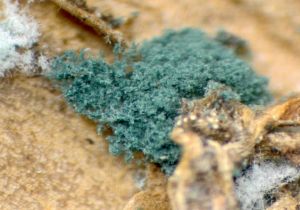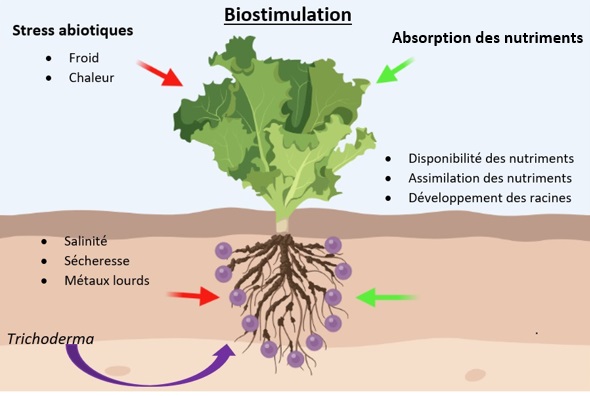Trichoderma

Trichoderma is an ascomycete fungus of the Hypocreaceae family. It interacts with roots, leaves and soil. Many species are used as biocontrol products, either as fungicides or as biostimulants. Some species and strains are more effective at achieving symbioses in the rhizosphere (biostimulation) and others more effective at colonising the entire plant, protecting it from fungal diseases (antifungal action).[1]

Trichoderma as a biostimulant
According to EU regulations[2]a plant biostimulant is "a product that stimulates the nutritional processes of plants, irrespective of the nutrient content of the product, for the sole purpose of improving one or more of the following characteristics" :
- Nutrient uptake by the plant
- Tolerance to abiotic conditions
- General quality of the plant (growth, yield, etc.)
- Availability of nutrients in the soil and rhizosphere
- Plant resistance to pathogens
For more details, please refer to the diagram below.[2][1]

Examples of Trichoderma strains to use depending on the crops and effects sought
The following list gives some examples of Trichoderma strains that can be used for biostimulation, as well as their positive effects on certain crops. This is an informative list, and some of the strains cited are not marketed in France :
Commercial strains
Wheat :
Trichoderma harzianium T22[3] :
- Under salt stress, increased biomass, proline and IAA content.
- Improved photosynthesis and water use.
Durum wheat :
Trichoderma harzianium T22[4] :
- Under normal conditions and drought stress, increased growth, biomass and yield.
Strawberry :
Trichoderma harzanium T22[5] :
- Increased biomass, yield, nutrient uptake.
Non-commercial strains
Lettuce :
Trichoderma virens GV41[6] :
- Increased phenol content and antioxidant activity.
- Improvesnitrogen utilisation efficiency.
Rocket :
Trichoderma virens GV41[7] :
- Increased biomass, yield, phenol content and antioxidant activity.
- Antioxidants, improved efficiency of nitrogen use and absorption.
Soya :
Trichoderma spp (Trichoderma combined)[8] :
- Increased growth.
- Increase in the fatty acid and mineral content of the seeds.
Melon :
Trichoderma saturnisporum[9] :
- Improves germination.
- Increases plant vigour and yield.
Sunflower :
Trichoderma ligibrachiatum[10] :
- Helps plants under stressful conditions thanks to its antioxidant activity.
Tomato :
Trichoderma harzianium AK20G[11] :
- Helps combat cold stress.
Trichoderma as a fungicide
The fungicidal effect of Trichoderma is defined by :
- Spatial competition : It prevents the pathogenic fungus from establishing itself, by taking its place.
- Competition for nutrients : When it is present in the rhizosphere, it captures the nutrients needed by the pathogen to develop.
- Parasitism : It produces antifungal substances that kill the pathogen by destroying its cell wall. Trichoderma spp parasitises the fungus using a specialised organ to feed on the contents of its cells.
For more details refer to the diagram below. [12][1]
Use of Trichoderma
Biocontrol products associated with Trichoderma species
Biocontrol products are legally considered to be plant protection products (PPPs), subject to Marketing Authorisation (MA). Biocontrol status is awarded to products on the basis of a list of criteria, including : the exclusion of certain environmental and health hazards, the natural origin of the active substances, etc. All the criteria are available in the Ministry's note, the link to which can be found here.
As regards biocontrol products based on micro-organisms such as Trichoderma, which can have both a biostimulant and fungicidal effect, the regulations governing marketing authorisations can be tedious and very costly for companies. It is for these reasons that certain strains of Trichoderma are marketed as a biostimulant OR as a fungicide, even though they could theoretically have both effects.
The list below shows the species and strains of Trichoderma marketed in France. For information on the legal use of each product, check the Ephy - Anses website :
Trichoderma asperellum strain ICC012 and T. gamsii strain ICC080 :
- Product marketed.
- Action: Fungicide.
- Diseases: Esca on grapevine.
- Crops: Vine.
Trichoderma asperellum strains ICC012 T25 and TV1 :
- Product marketed.
- Action: Fungicide.
- Diseases: Pythium, Rhizoctonia, Verticillium, Phytophthora.
- Crops: Cucumbers, courgettes, tomatoes, pome fruit, grapes, potatoes, lettuce, etc.
- Product marketed.
- Action: Fungicide, biostimulant.
- Diseases: Fusarium, Pythium, Rhizoctonia, Sclerotinia, Botrytis, Phytophthora.
- Crops: Cucumbers, courgettes, tomatoes, pome fruit, grapes, potatoes, lettuce, etc.
Trichoderma atroviride I-1237 :
- Product marketed.
- Action: Fungicide, Biostimulant.
- Diseases: Pythium, Rhizoctonia.
- Crops: Lettuce, carrots, potatoes, ornamental crops.
Trichoderma atroviride I-1237 :
- Product marketed
- Action: Fungicide
- Diseases: Esca on grapevine, Excoriosis, black dead arm.
- Crops: Vine.
- Product marketed.
- Action: Fungicide.
- Diseases: Phaeomoniella chlamydospora, Phaeoacremonium aleophilum ( vine trunk diseases).
- Crops: Vine.
Trichoderma atroviride strain T11 and T. asperellum strain T25 :
- Product marketed.
- Action: Fungicide, Biostimulant.
- Diseases: Phytophthora, Sclerotinia, Fusarium, Pythium, Rhizoctonia.
- Crops: Strawberry, lettuce, tomato, cucumber, melon, ornamental crops.
Trichoderma harzianum Rifai strains T-22 and ITEM-908 :
- Product marketed.
- Action: Fungicide.
- Diseases: Fusarium, Pythium, Rhizoctonia, Sclerotinia.
- Crops: Peppers, cucumbers, tomatoes, iceberg lettuce, ornamental crops.
Trichoderma harzianum Rifai strains T-22 and ITEM-908 :
- Product marketed.
- Action: Fungicide, Biostimulant.
- Diseases: Fusarium, Pythium, Rhizoctonia, Sclerotinia.
- Crops: pepper, cucumber, tomato, iceberg lettuce, ornamental crops.[13].
Preventive / Curative
Generally speaking, Trichoderma-based products are most effective as a preventive measure, in conjunction with a conventional soil treatment. The following information follows on from the article"Managing Bremia on lettuce using micro-organisms", which uses the example of Trichoderma atroviride on lettuce.[14][15].
As a preventive measure
Trichoderma atroviride is most effective when used as a preventive solution. It should be applied at the start of the crop before sowing or planting, by spraying just before the final soil preparation, to ensure even distribution over the first few centimetres.
It is available in wettable powder (WP) form from retailers. To be effective, the application of Trichoderma atroviride must be preceded by prophylactic practices to limit the appearance of the fungal disease :
- Choosing a Bremia-resistant variety.
- Manage planting density.
- Aerate shelters.
- Use reasoned fertilisation.
- Solarise if there was a major Bremia problem the previous year.
- Keep the area around greenhouses clean and tidy.
Curative treatment
Trichoderma atroviride is not very effective on lettuce when the pathogen is already established in the crop and the first symptoms appear. Preventive use is nevertheless preferable. The product isapplied curatively to the leaves to treat airborne fungal diseases.
Product storage and handling
Storage
Most Trichoderma products on the market are stored in aluminium sachets to avoid altering the quality of the product. Take care to respect the storage conditions recommended by the supplier (temperature and exposure to light). Before using the product, always check the use-by date, as these types of products generally have an optimal shelf life of 6 months. For more information, consult the instructions for use.
Handling the product
For more complete information on handling Trichoderma atroviride-based products, please refer to Ephy, the following information is taken from that site.
In the case of application using a backpack sprayer or hand-held lance or equivalent or for ground mixing :
Products containing Trichoderma as an active substance are considered to be plant protection products (PPPs) by legislation, and are therefore subject to the same precautions for use as PPPs.
During mixing/loading :
- EN 374-3 certified nitrile gloves.
- Work overalls in polyester 65 %/cotton 35 % with a grammage of 230 g/m² or more with water-repellent treatment.
- Partial PPE (long-sleeved blouse or apron) of category III and type PB (3B) to be worn over the above-mentioned overalls.
- Certified respiratory protection : certified aerosol filtering half-mask (EN 149) class FFP3 or certified half-mask (EN 140) fitted with a certified aerosol filter (EN 143) class P3.
During application :
- Category III type 4B protective suit with hood.
- Nitrile gloves certified to EN 374-3.
- Certified respiratory protection : certified aerosol filtering half-mask (EN 149) class FFP3 or certified half-mask (EN 140) fitted with a certified aerosol filter (EN 143) class P3.
When cleaning spray equipment :
- Nitrile gloves certified to EN 374-3.
- Work overalls made of polyester 65 %/cotton 35 % with a grammage of 230 g/m² or more with water-repellent treatment.[15]
- Partial PPE (long-sleeved blouse or apron) of category III and type PB (3B) to be worn over the above-mentioned overalls.
- Certified aerosol filtering half-mask (EN 149) class FFP3 or certified half-mask (EN 140) fitted with a certified aerosol filter (EN 143) class P3.
- Safety goggles complying with regulations and standard EN 166
- Protective boots complying with regulations and standard EN 13 832-3.
During application :
- Coveralls made of 65 % polyester/35 % cotton with a grammage of 230 g/m² or more with water-repellent treatment.
- Protective boots complying with regulations and standard EN 13 832-3.
If applying with a lance, backpack sprayer or by brushing :
- Reusable nitrile gloves certified to EN 374-3
- FFP3 category filtering half-mask certified to EN 149
- Waterproof clothing, long-sleeved blouse complying with category III and type PB 3 certified regulations, to be worn over the overalls.
Regulations
The list of biocontrol plant protection products in France is governed by the Ministry of Agriculture and Food. Current regulations : DGAL/SAS/2022-57 of 19 January 2022.
The list of products authorised for use in France is kept up to date by the Anses (Agence nationale de sécurité sanitaire de l'alimentation, de l'environnement et du travail).
With regard to the regulations governing theuse and handling of biostimulants in agriculture, the specifications for the European Union are imposed by the European Parliament and the Council of the European Union. The current regulation is (EU) 2019/1009. The product is authorised for use in organic farming.[16]
Annexes
References
- ↑ 1.0 1.1 1.2 Nakkeeran, S., Vinodkumar, S.,Priyanka, R. and Renukadevi, P. Mode of Action of Trichoderma Spp. in Biological Control of Plant Diseases
- ↑ 2.0 2.1 Baltazar, M., Correia, S., Guinan, K. J., Sujeeth, N., Bragança, R., & Gonçalves, B. (2021). Recent advances in the molecular effects of biostimulants in plants: An overview. In Biomolecules (Vol. 11, Issue 8). MDPI AG. https://doi.org/10.3390/biom11081096
- ↑ Oljira, A. M., Hussain, T., Waghmode, T. R., Zhao, H., Sun, H., Liu, X., Wang, X., & Liu, B. (2020). Trichoderma Enhances Net Photosynthesis, Water Use Efficiency, and Growth of Wheat(Triticum aestivum L.) under Salt Stress. Microorganisms 2020, Vol. 8, Page 1565, 8(10), 1565. https://doi. org/10.3390/MICROORGANISMS8101565
- ↑ Silletti, S., di Stasio, E., van Oosten, M. J., Ventorino, V., Pepe, O., Napolitano, M., Marra, R., Woo, S. L., Cirillo, V., & Maggio, A. (2021). Biostimulant Activity of Azotobacter chroococcum and Trichoderma harzianum in Durum Wheat under Water and Nitrogen Deficiency. Agronomy 2021, Vol. 11, Page 380, 11(2), 380. https://doi. org/10.3390/AGRONOMY11020380
- ↑ Lombardi, N., Caira, S., Troise, A. D., Scaloni, A., Vitaglione, P., Vinale, F., Marra, R., Salzano, A. M., Lorito, M., & Woo, S. L. (2020). Trichoderma Applications on Strawberry Plants Modulate the Physiological Processes Positively Affecting Fruit Production and Quality. Frontiers in Microbiology, 11, 1364. https://doi. org/10.3389/FMICB.2020.01364/BIBTEX
- ↑ Visconti, D., Fiorentino, N., Cozzolino, E., Woo, S. L., Fagnano, M., & Rouphael, Y. (2020). Can Trichoderma-Based Biostimulants Optimize N Use Efficiency and Stimulate Growth of Leafy Vegetables in Greenhouse Intensive Cropping Systems? Agronomy 2020, Vol. 10, Page 121, 10(1), 121. https://doi. org/10.3390/AGRONOMY10010121
- ↑ Visconti, D., Fiorentino, N., Cozzolino, E., Woo, S. L., Fagnano, M., & Rouphael, Y. (2020). Can Trichoderma-Based Biostimulants Optimize N Use Efficiency and Stimulate Growth of Leafy Vegetables in Greenhouse Intensive Cropping Systems? Agronomy 2020, Vol. 10, Page 121, 10(1), 121. https://doi. org/10.3390/AGRONOMY10010121
- ↑ Marra, R., Lombardi, N., D'Errico, G., Troisi, J., Scala, G., Vinale, F., Woo, S. L., Bonanomi, G., & Lorito, M. (2019). Application of Trichoderma Strains and Metabolites Enhances Soybean Productivity and Nutrient Content. Journal of Agricultural and Food Chemistry, 67(7), 1814-1822. https://doi. org/10.1021/ACS.JAFC.8B06503
- ↑ Fernando, D., Milagrosa, S., Francisco, C., & Francisco, M. (2018). Biostimulant Activity of Trichoderma saturnisporum in Melon (Cucumis melo). HortScience, 53(6), 810-815. https://doi. org/10.21273/HORTSCI13006-18
- ↑ Devi, S. S., Sreenivasulu, Y., & Rao, K. B. (2017). Protective role of Trichoderma logibrachiatum (WT2) on Lead induced oxidative stress in Helianthus annus L. IJEB Vol.55(04) [April 2017], 55, 235-241. http://nopr. niscair.res.in/handle/123456789/41180
- ↑ Ghorbanpour, A., Salimi, A., Ghanbary, M. A. T., Pirdashti, H., & Dehestani, A. (2018). The effect of Trichoderma harzianum in mitigating low temperature stress in tomato (Solanum lycopersicum L.) plants. Scientia Horticulturae, 230, 134-141. https://doi. org/10.1016/J.SCIENTA.2017.11.028
- ↑ Harman GE, Howell CR, Viterbo A, Chet I, Lorito M. Trichoderma species - opportunistic, avirulent plant symbionts. Nat Rev Microbiol. gennaio 2004;2(1):43-56.
- ↑ Nicot, Pressecq, Bardin. 2021. Chapter 2 in Advances in bioprotectants for plant disease control in horticulture. In: Improving integrated pest management (IPM) in horticulture (ed. R. Collier). Buleigh Dodds Science Publishing, in press " with P C Nicot et M. Bardin
- ↑ https://paca.chambres-agriculture.fr/?id=2831176&tx_news_pi1%5Bnews%5D=88538&tx_news_pi1%5Bcontroller%5D=News&tx_news_pi1%5Baction%5D=detail&cHash=cde3b3417a976d7b7960f534259ca587
- ↑ 15.0 15.1 https://ephy.anses.fr/ppp/tri-soil
- ↑ GuideProtection-LotetGaronne-Laitue-2014.pdf (chambre-agriculture.fr)
